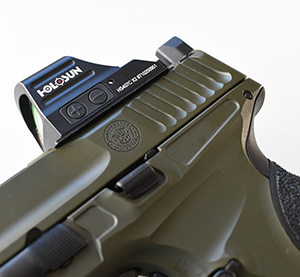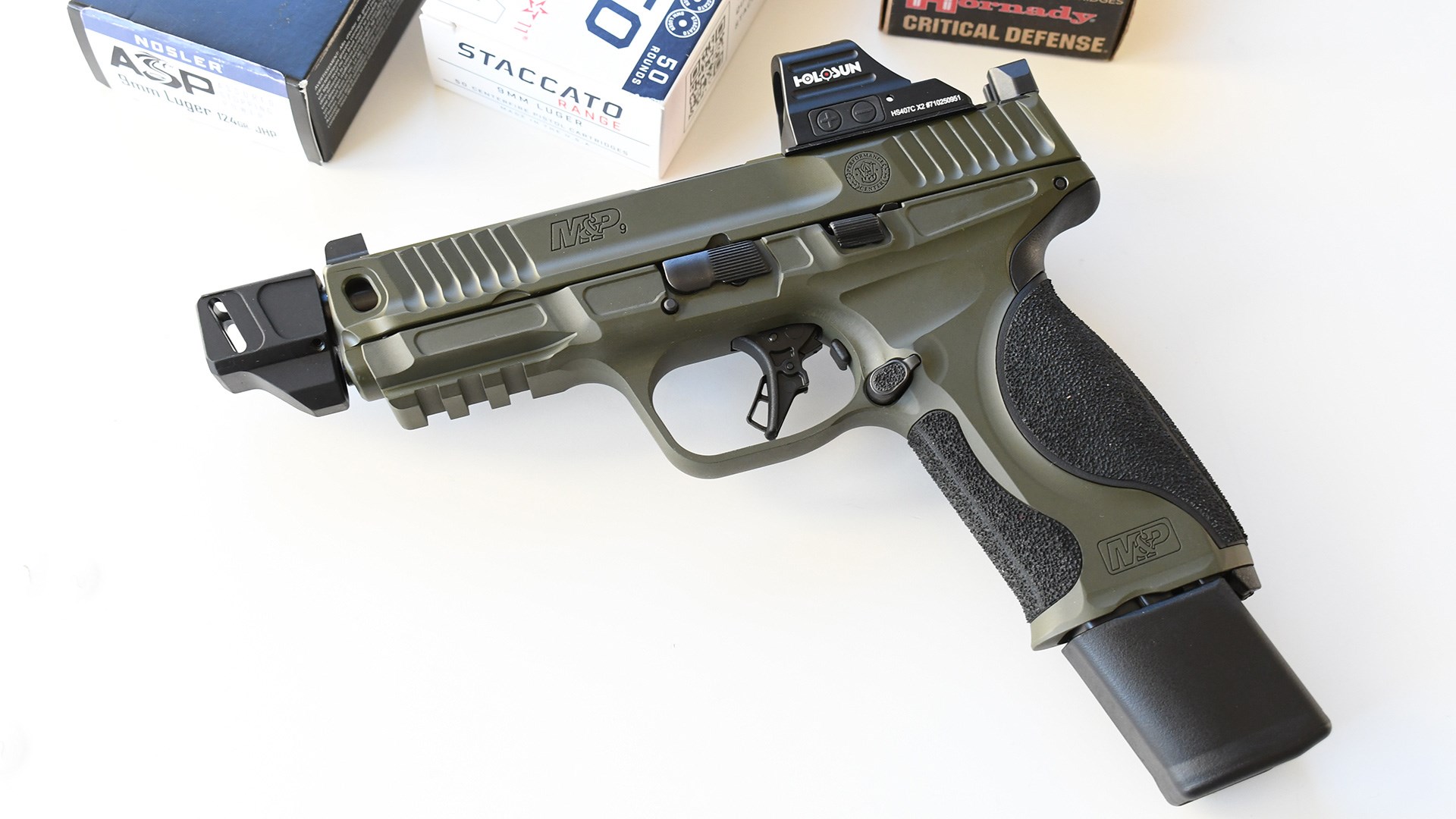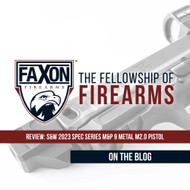Review: S&W 2023 Spec Series M&P 9 Metal M2.0 Pistol
Posted by Shootingillustrated.com on Mar 12th 2024
Originally posted here.
Top of the line performance at a surprisingly affordable price.
Smith & Wesson started releasing special-edition versions of its M&P9 M2.0 pistols four years ago under the Smith & Wesson Spec Series banner. Those special-edition firearms include additional details like custom finishes, extra magazines, bigger carrying cases, challenge coins and collectible knives. The recently released 2023 edition consists of a full-size aluminum-frame M&P9 M2.0 Performance Center pistol with an attractive olive-drab-green Cerakote finish and a 4.8-inch threaded barrel with a compensator manufactured by Faxon Firearms. This new handgun also ships in an oversize carrying case that includes a total of four magazines (two 17-round standard magazines and two 23-round extended capacity magazines), a thread protector (when not shooting with the compensator), a 2023 Spec Series challenge coin and a Karambit knife.
Overview
Besides the attractive olive-drab-green Cerakote finish, other significant differences between this gun and the standard M&P9 M2.0 Metal model are the longer 4.8-inch threaded barrel with a Faxon Firearms compensator, a slide with three distinct lightening cuts on the slide near the muzzle for weight reduction and non-wavy front-and-rear slide serrations. The 2023 M&P9 M2.0 SPEC also includes an enhanced Performance Center sear that gives this gun an average 4-pound trigger-pull weight. A small Performance Center logo is rollmarked on the left side of the slide ahead of the slide serrations.
Sights and the S&W CORE Optics System
 The front and rear dovetails of the slide and suppressor-height, three-dot tritium night sights clear the bases of most red-dot optic bodies and can co-witness with the optics. I prefer plain/serrated black rear iron sights with a single dot on the front sight only, but this setup makes a set of nice sights. Unlike previous reviews, where I shot with iron-sights only, this time I made use of Smith & Wesson's CORE optics-ready mounting system by attaching a reflex sight I had available. Smith & Wesson's CORE system is unique due to its deeply-drilled semi-universal screw-hole patterns that also includes seven different mounting plates. Unlike typical metal mounting plates, CORE plates are thinner and made from polymer; they act more like shims to align the optic’s footprint specifically in place to properly fasten an optic. The CORE system omits the use of standard recoil bosses, but two circular lugs are found longitudinally along the middle of the cut, which the CORE polymer mounting plate uses to index the sight on the slide. The CORE system works with longer screws to better anchor optics over the uniquely deep-set CORE screw holes. Smith & Wesson includes the screws, which are mixed and matched depending on the optic itself. All screws came with a generous amount of thread locker, and in the 250 rounds or so I fired through the M&P9 SPEC for this review, the screws were still snugly in place after torquing to 18 inch-pounds. All S&W supplied screws work off a 5/64-inch hexagonal screw-head, which I don’t care much for. I believe these screws would be better off using a Torx T10 or T15 pattern to better prevent the risk of slippage and stripped heads. In fairness, 250 rounds fired is far from a comprehensive figure to fully judge the merits of the CORE system.
The front and rear dovetails of the slide and suppressor-height, three-dot tritium night sights clear the bases of most red-dot optic bodies and can co-witness with the optics. I prefer plain/serrated black rear iron sights with a single dot on the front sight only, but this setup makes a set of nice sights. Unlike previous reviews, where I shot with iron-sights only, this time I made use of Smith & Wesson's CORE optics-ready mounting system by attaching a reflex sight I had available. Smith & Wesson's CORE system is unique due to its deeply-drilled semi-universal screw-hole patterns that also includes seven different mounting plates. Unlike typical metal mounting plates, CORE plates are thinner and made from polymer; they act more like shims to align the optic’s footprint specifically in place to properly fasten an optic. The CORE system omits the use of standard recoil bosses, but two circular lugs are found longitudinally along the middle of the cut, which the CORE polymer mounting plate uses to index the sight on the slide. The CORE system works with longer screws to better anchor optics over the uniquely deep-set CORE screw holes. Smith & Wesson includes the screws, which are mixed and matched depending on the optic itself. All screws came with a generous amount of thread locker, and in the 250 rounds or so I fired through the M&P9 SPEC for this review, the screws were still snugly in place after torquing to 18 inch-pounds. All S&W supplied screws work off a 5/64-inch hexagonal screw-head, which I don’t care much for. I believe these screws would be better off using a Torx T10 or T15 pattern to better prevent the risk of slippage and stripped heads. In fairness, 250 rounds fired is far from a comprehensive figure to fully judge the merits of the CORE system.
Is It Compensating For Something?
Smith & Wesson collaborated with Faxon Firearms to create the 2023 M&P9 M2.0 PC SPEC’s compensator that screws onto the threaded muzzle and is timed manually. Two setscrews at 4- and 7-o’clock secure the device in place. For additional security when firing, a recess on the rear lower portion of the compensator catches the M&P’s guide-rod any time the slide is retracted. Compensators work by redirecting the expanding gasses from burning propellant upwards to counteract muzzle-flip. Dedicated compensated-handgun shooters generally tailor their loads and select for propellants that produce a voluminous amount of gas in order to actuate the compensator. Compensator effectiveness will depend on the firearm, the shooter and ammunition selection.
The M&P 9 SPEC On The Range

Being that this is a Performance Center pistol with a red-dot sight, I couldn’t wait for the live-fire portion of my review. To get a feel for the gun, after first confirming zero, I burned some 7-yard A-Zone Bill Drill reps from concealment using my PHLster Floodlight 2. Besides accuracy testing, I also fired 90 rounds across three runs of the Hardwired Tactical Shooting’s Advanced Super Test and my best score was a 288/300 (10.12 seconds at 15 yards, 6.06s at 10 yards and 3.77 seconds at 5 yards). Similarly, I also scored my current personal best Bill Drill time of 2.55 seconds that day. It didn’t take much for the pistol’s performance potential to reveal itself. Compensated or not, this gun’s handling and shooting characteristics give it a great return to zero and an easy-tracking slide. During rapid fire strings, I just kept watching the dot indexing nearly in the same spot every time.
The 9mm ammunition used in this review include Hornady's 115-grain JHP Critical Defense, Staccato 2011’s new 124-grain FMJ rounds and Nosler’s 124-grain ASP JHP ammo. The bulk of my shooting involved several boxes of 115-grain Blazer Aluminum FMJs, and I also brought 100 rounds of 124-grain handloads loaded with 6.6-grains of HS-6. These handloads were the gassiest 9mm ammunition on-hand, and I wanted to see how the compensator handled them. After 80 rounds, I didn’t [subjectively] perceive much difference, so I shot the remainder of the review without the compensator. Since all of my draws were done from concealment, taking the compensator off made it easier to reholster. The M&P 2.0 series addressed some of the original M&P’s shortcomings, so accuracy wasn’t a concern in the least. This gun really took a liking to Staccato 2011’s new 124-grain FMJ rounds and printed them very consistently on the target.
The Takeaway
The M&P 9 2.0 PC SPEC isn’t the first M&P 2.0 I’ve reviewed, and every time I review one, I become more fond of these pistols. These guns have an 18-degree grip angle that takes after 1911 pistols, while their grip contours and backstrap insert shapes make for guns that fit most people’s hands well. The grip’s synergy also translates into a gun that is easy to draw and point well, so regardless of “trim” level of a particular M&P 2.0, it’s the foundation of a pistol capable of high-performance shooting. With regards to the 2023 M&P 9 2.0 PC SPEC, don’t let the challenge coin, Karambit knife or special OD Green Cerakote fool you into thinking this is just some milquetoast special release. Out of the box, this gun is very capable–just add a dot and holster.
S&W M&P9 M2.0 SPEC Series Specifications:
- Make: Smith & Wesson
- Caliber: 9mm
- Action: Striker-fired, semi-automatic
- Overall Length: 8.5 inches
- Width: 1.3 inches
- Height: 5.5 inches
- Weight: 30 ounces
- Barrel Length: 4.8 inches
- Frame Material And Finish: Aluminum alloy w/ OD green cerakote
- Slide Material And Finish: Stainless steel w/ OD green cerakote
- Trigger: Smith & Wesson Performance Center enhanced sear, 4.0-pound break
- Magazine Capacity: 23 or 17 rounds (includes 4 magazines)
- Sights: Three-dot tritium, suppressor-height night sights
- Optics-Ready: Yes, Smith & Wesson CORE System
- Accessories: Faxon Firearms Compensator, Challenge Coin, Karambit Knife
- MSRP: $999
25-yard Accuracy Report
| Ammo: 9mm | Smallest Group (inches) | Average Group (inches) | Largest Group (inches) |
| Hornady Critical Defense 115-grain JHP | 1.75 | 2.38 | 3.00 |
| Staccato 2011 Range 124-grain FMJ | 1.50 | 2.19 | 2.50 |
| Nosler Advanced Stopping Power 124-grain JHP | 2.00 | 2.69 | 3.50 |

